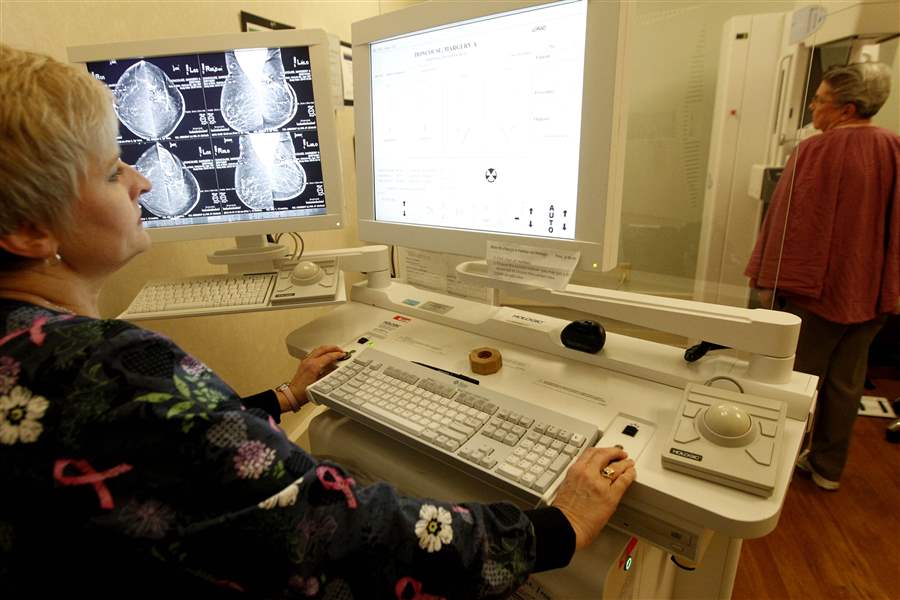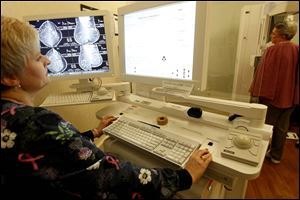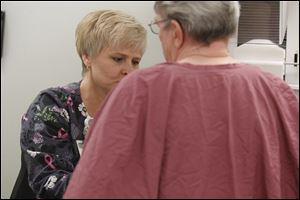
On the Job: Technologist eases patient fears as she performs imaging exams
10/26/2013
Jenny Kulish performs a mammogram for breast cancer survivor Margery Doncouse, right, in the Breast Care Center at Toledo Hospital in the Harris McIntosh Tower.
The Blade/Amy E. Voigt
Buy This Image

Jenny Kulish performs a mammogram for breast cancer survivor Margery Doncouse, right, in the Breast Care Center at Toledo Hospital in the Harris McIntosh Tower.
Before she knocks on the door to an exam room, Jenny Kulish puts on her best happy face.
It’s not for her, but for the person waiting inside. The Breast Care Center at Toledo Hospital can be a scary place for patients. It’s where mammograms, biopsies, and breast cancer diagnoses take place. It’s also where patients find out that not all lumps are cancerous and not all cancers are life-ending.
But until they see Mrs. Kulish, or one of the other radiology technologists in the office, fear of the unknown wells up and takes over.
Breast cancer is the most common cancer in women, regardless of race or ethnicity, the Centers for Disease Control and Prevention reports. In 2009 (the most recent year numbers are available), more than 200,000 women and 2,000 men in the United States were diagnosed with the disease. More than 40,000 women and 400 men died because of it.
Every year during the month of October, races are run and funds are raised to help spread awareness, promote research, and educate communities about breast cancer.
The woman waiting inside the exam room on a recent day was called back into the office after clouds of white tissue showed up on her mammogram. Abnormalities show up white on the images. Like Mrs. Kulish, she put her best face forward.
“Did they find something?” she asked Mrs. Kulish. “What are they looking at that’s bad?”
Careful, but honest, Mrs. Kulish told her “yes, but it’s not necessarily bad. It’s just different from your prior exams.”
They walked over to the computer where Mrs. Kulish showed the woman images of previous mammograms. Mrs. Kulish explained the difference between fatty and dense breasts, informing the woman that her breasts are dense and that makes images harder to read.
“See this right here? When we press your breast, we want that to separate,” Mrs. Kulish told the woman as she pointed out the clumps of tissue. “It could just be overlapping tissue, but until we take a further look, it’s like picking out the snowman in the snowstorm.”

Jenny Kulish, left, performs a mammogram for breast cancer survivor Margery Doncouse in the Breast Care Center at Toledo Hospital in the Harris McIntosh Tower.
Mrs. Kulish and her colleagues at the Breast Care Center see 50 to 75 patients a day. The team provides comprehensive breast care in a one-stop shop: mammograms, biopsies, ultrasounds, and consultations with a variety of doctors all take place at the clinic.
Most patients are women, but the clinic sees about five men per month. While eight out of every 10 patients who are called back have benign, noncancerous tumors, 25 patients receive a breast cancer diagnosis every month at the center.
The 15 technologists, all women, spend their down time in a narrow corridor doing paperwork and catching up with each other. They discuss everything from children and grandchildren to TV shows.
“We have to laugh,” Mrs. Kulish said. “It’s easy to get emotional with everything that goes on here.”
Mrs. Kulish, of Toledo, has worked as a radiology technologist for 29 years. She performs imaging examinations on breasts and those images are used for diagnostic purposes. In addition to her work at the clinic, she also speaks to students in the radiology program at Owens Community College.
She’s warm and comforting with her patients, often apologizing for the cumbersomeness of the machines she uses to do her work. During exams, her hand rests on the patient’s back, offering support.
“There’s a person attached to that breast,” Mrs. Kulish said. “Most of the time, they’re already scared. We’re there to help them through that.”
Two years ago, Mrs. Kulish had to offer that same hand of support to a person much closer to her. Her mother, then 87 years old, felt a lump in a breast. It was cancer.
“It was scary,” Mrs. Kulish said. “I had to be the daughter. Not the technician.”
With her mother’s diagnosis, Mrs. Kulish now has a family history of the disease and her chances of getting breast cancer have increased significantly. Instead of just one exam annually, she gets two different exams.
While Mrs. Kulish is aware of her risks, statistics show that 20 percent of women with a new breast cancer diagnosis have no family history of the disease.
“A lot of women think they’re OK because they have no family history of breast cancer. That’s a false safety net,” she said. “Get your mammograms anyway. Don’t put it off. It’s not something you want to do, but we’ll get you through it.”
Contact RoNeisha Mullen at: rmullen@theblade.com or 419-724-6133.